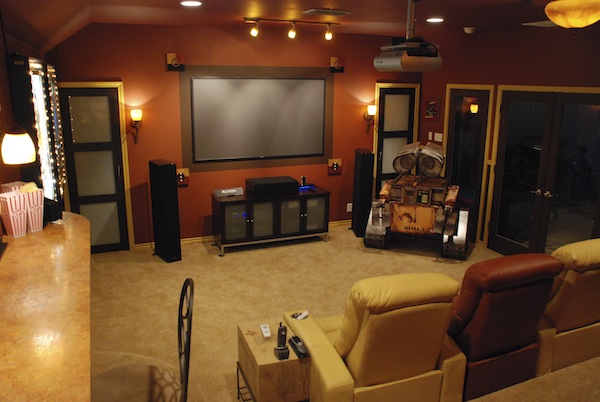A Note About Our Home Theater Submissions

Recently a reader wrote to me and asked why we didn’t feature “the average homeowner’s theater”. Point in fact, we do, however, we probably decline more than we accept. I’d like to address that and explain why.
The bulk of the big, glossy spreads you find in Home Theater, which eventually find their way here to Home Theater Design , are submitted directly to us by custom installers or the public relations firms that represent them. What makes these installations more publishable than the majority of the DIY (do it yourself) theaters I receive is the consistency of the interior design, the cleanliness of the installation, and the photography. Believe it or not we would be just as happy to publish an average size home, with modest furnishings and decor, as long as those three criteria were met.
We want to make room in our publications for both the large, whole-home installs as well as the DIY projects. We chose DIY systems primarily for their creativity and complexity, not only in design but in construction, too. The very best ones could easily be mistaken for a professional installation. That said, we’ve had to decline some very interesting DIY installs, not because the homeowner didn’t do a good job, but because the photography was not up to par for the purposes of printing. Some of those have made it into HTD but not all.
The idea behind HTD is not just to post a lot of installs and pretty pictures but to educate and hopefully, inspire other readers. Installations that incorporate basic IKEA furniture, older AV components, and wiring strewn across the room may be a typical average man’s home theater but it’s not particularly inspiring to those who are ready to go beyond that.
When submitting DIY theaters for consideration in Home Theater, the photography has to be impeccable and you can certainly get an idea of what we are looking for by studying the photography in both our print and online publications. The picture I posted at the top was of a DIY home theater we published in Home Theater magazine due it's extraordinary workmanship and vision. I am providing a few more here.


This next install was constructed inside a mobile home and the one after that the homeowner developed a conveyer belt to help move the stone out of the basement. That’s what I call ingenuity and dedication.


In all these photographs you’ll notice an evenness of light (highlights are not too hot, shadows still have detail), colors and tones are accurate, the image is crisp and clear (no visible noise). Basically, the overall appearance is extremely clean but more importantly we are impressed by their accomplishment and want to hear their story. There are no wires anywhere, the room is devoid of general clutter, the installation is relatively new so the equipment is up to date. These installations certainly rival that of the pros.
When it comes to shooting photography that has that "commercial" look, it takes skill and knowledge. As handy as they may be, point-and-shoot cameras rarely have the quality to meet our requirements. If the room is dark, the camera self adjusts for the lack of light, creating a good deal of visible noise (looks like white speckles) and reduced (if any) detail in the shadows. Using a flash is equally problematic, there are harsh shadows and a “hot spot” in the middle of the image, often bouncing off the most reflective object in the room, which is usually the TV screen. Of course, these problems can be easily duplicated with a DSLR in the hands of a novice, too.
Now you might be thinking, I can’t afford to hire a pro photographer and you don’t necessarily have to. Perhaps, you have a friend or relative with photographic skills. Even images that are less than perfect make it into the HTD website, however, for inclusion in Home Theater, photographic quality is paramount. Rather than fire off a couple of snaps, take some time to figure out how you can best demonstrate to us your DIY efforts.
Beyond the photography, I challenge DIYers to start thinking about the overall interior design. Is there some consistency to the interior design or is there just a bunch of unmatched furniture scattered about? Did you bother to conceal the wires in some fashion? Are their extraneous objects that could have been removed before taking the picture? Is there a theme or cohesive design element? Is the AV equipment relatively state-of-the art? (Though, I don’t expect you to all have 2.35:1 screens or be 3D capable.) How did you stretch your own skill sets and knowledge to build something you once thought only a pro could offer? I urge you to read the interview I conducted with Barbara Roth, a consultant that created a wonderful DVD to help homeowner’s make good design decisions when creating a home theater or media room.
When submitting installations for consideration, please follow our guidelines, they are not arbitrary. Like most email inboxes I have a limited capacity, so for evaluation purposes 2-4 low-res versions (of your high-res files) are all that’s required. (Please, don’t embed images into a Word document, they not only make the file too big, they are unusable.) From that we can tell if the photography is going to work and if it’s a theater we believe our readers are going to appreciate. We ask for a brief description in your original email. If you are chosen for publication we'll request something more detailed that focuses on the key highlights of the theater. We also like to hear about any challenges you overcame. So be prepared for this by reading the many reader’s interiors we have already published to see how they were written. Unfortunately, we have received good images that were never published because the homeowner didn’t provide the additional details we requested.
Thanks for your continued readership and I look forward to receiving your submissions. Now that you have a greater understanding of our selection process, I hope it will be possible to publish even more of them in the future.
Editor, Home Theater Design
- Log in or register to post comments






















































